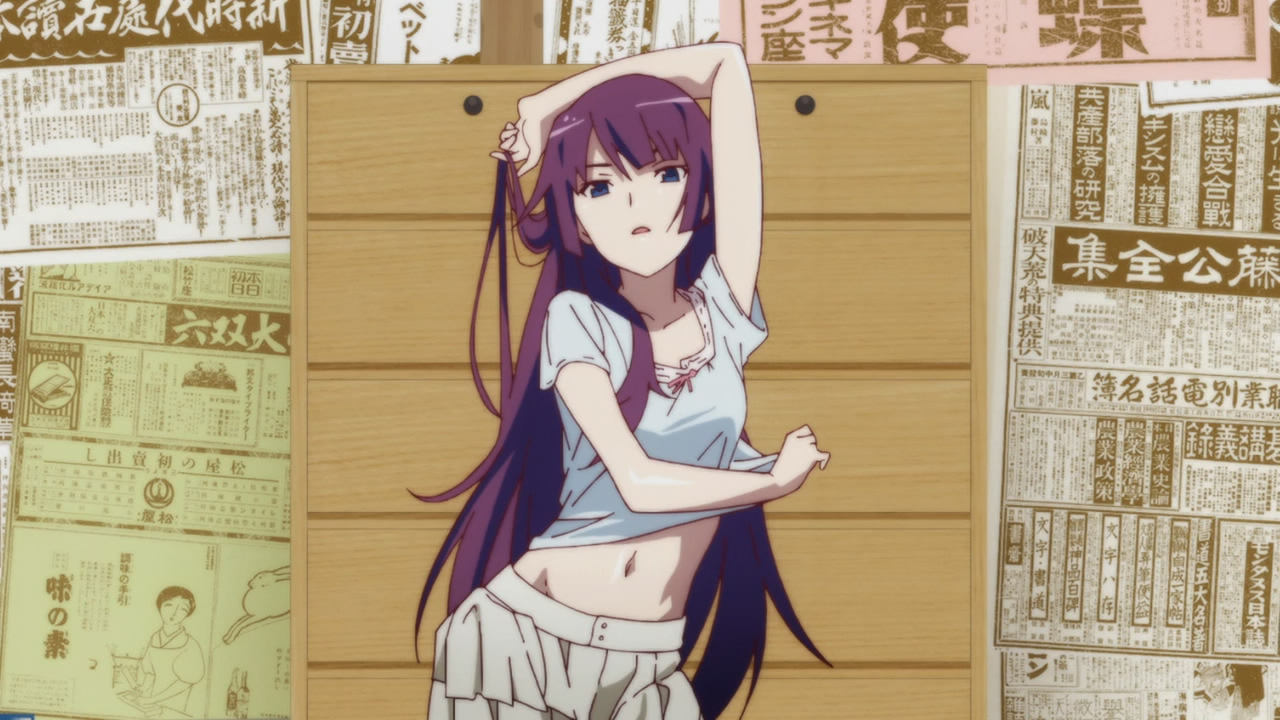Welcome to Part 2 of my Monogatari Series review, today we’ll be taking a look at the second season to the Series, Nisemonogatari (Second season in terms of release/airing date). A quick disclaimer to all, The second season is probably my most favourite season out of the entirety of the series; so do expect this today’s blog to be quite lengthy and very wordy – so sorry!
Also, if you’re a true Anime veteran, then you probably have heard of that toothbrushing scene; well it’s in this Anime.
Now, the main sticking point with Nisemonogatari has been the storyline, which was quite slow in its progression; if you’ve recently read about the ‘fast-paced, clever storyline’, and are quite surprised by this assertion, then I shall elaborate; the first three episodes reintroduced characters from the first series, and while the Karen Bee arc was supposedly seven episodes long, it really did drag at points. In addition to that, the resolutions of each arc felt way too easy, and while we’re on it, the almost-complete absence of Tsukihi from the first two episodes of her own arc was bizarre.
Although it initially wasn’t promising, the story did become more interesting as the series went on, although I believe there will be further episode releases post-broadcast, because not everything came to a conclusion within the eleven episodes. I think the best way to see Nisemonogatari is as the bridging point which sets everything up nicely for a third series, and in terms of introducing characters who will probably play a part in these later series, it does a pretty good job. Contrary to the impression I might have made, I did enjoy watching this, but I do think it could have been better.
The art style is extremely effective. I don’t think I’ve ever seen anything quite like it before. The background art is most striking, with the use of colour-co-ordinated objects and scenery to create scenes which immediately grab the viewer’s attention. The much-debated black and red scenes seem to have been cut down on since Bakemonogatari, now only making a couple of appearances per episode, but the use of talking heads is still common. The background sets the atmosphere much more effectively than a show which is constrained by realism; just watch Kaiki Deishuu’s first screen appearance, and the shadows of the trees stretching out towards Koyomi, and you will realize the brilliance of this art style.
And now, the fanservice; how do they handle it? Well, what’s happening on-screen and the progression of the storyline is almost completely separate from one another, for starters. It’s nothing compared to an actual ecchi series, and the characters are wearing clothes it’s just the choice of shot and where it focuses on the character’s body that makes it fanservice. And when there are no clothes present, any details are obscured by the production team, preventing the need for masking or other censorship.

The sound hasn’t changed drastically from the first series; the episodes start with a blast of heavily distorted electric guitar, and a catchy pop-song opening, which is reminiscent of Staple Stable, to say the least. The lack of background music in Nisemonogatari compared to other series is noticeable, with only the occasional piano melody from the opening or ending slipped in at appropriate moments, but with the amount of dialogue that it has, this is actually a good thing.
It would be pointless including any more soundtrack, as it would just either pass completely over our heads or make it incredibly difficult to listen to. The ending is a pop-rock four-chord number which will probably get stuck in your head on an endless loop at some stage, and no amount of purging your memory with your own music collection will dislodge it. If you liked Bakemonogatari’s Staple Stable and Renai Circulation, then this is definitely worth a listen.
The characters from the first series remain as they are for the most part, with the exception of Hanekawa Tsubasa, who is now short-haired. Hitagi Senjougahara, self-diagnosed tsundere of the highest order, seems to have been relegated to a supporting role in Nisemonogatari, having only made three or so appearances in seven episodes; however, Araragi’s sisters, Karen and Tsukihi, step into the breach, so we have a net gain of characters. Connoisseur of Hawaiian t-shirts and supernatural phenomena Oshino Meme has disappeared, and the role of ‘sole adult in the series’ has gone to the much more evil, scheming Deishuu Kaiki, who looks like one of the creepier film incarnations of Dracula.
It’s interesting that they’ve gone for a central villain, rather than having different problems which are unrelated as per Bakemonogatari. It must be mentioned that in this series, the characters do not merely lean on the fourth wall, they’ve practically installed a revolving door in it for their convenience. Even the creation of the anime was slipped a thinly veiled reference in one of the characters’ metaphors. I quite like it, but you will need to know at least a little bit about the Monogatari franchise to get some of it.
If you want to support me and what I do,
please consider following me on Patreon.

Otaku Central



One response to “Nisemonogatari | The Monogatari Series – Part 2”
Are you really sure he is a viillian? That is a really NICE picture of Hitagi, by the way.